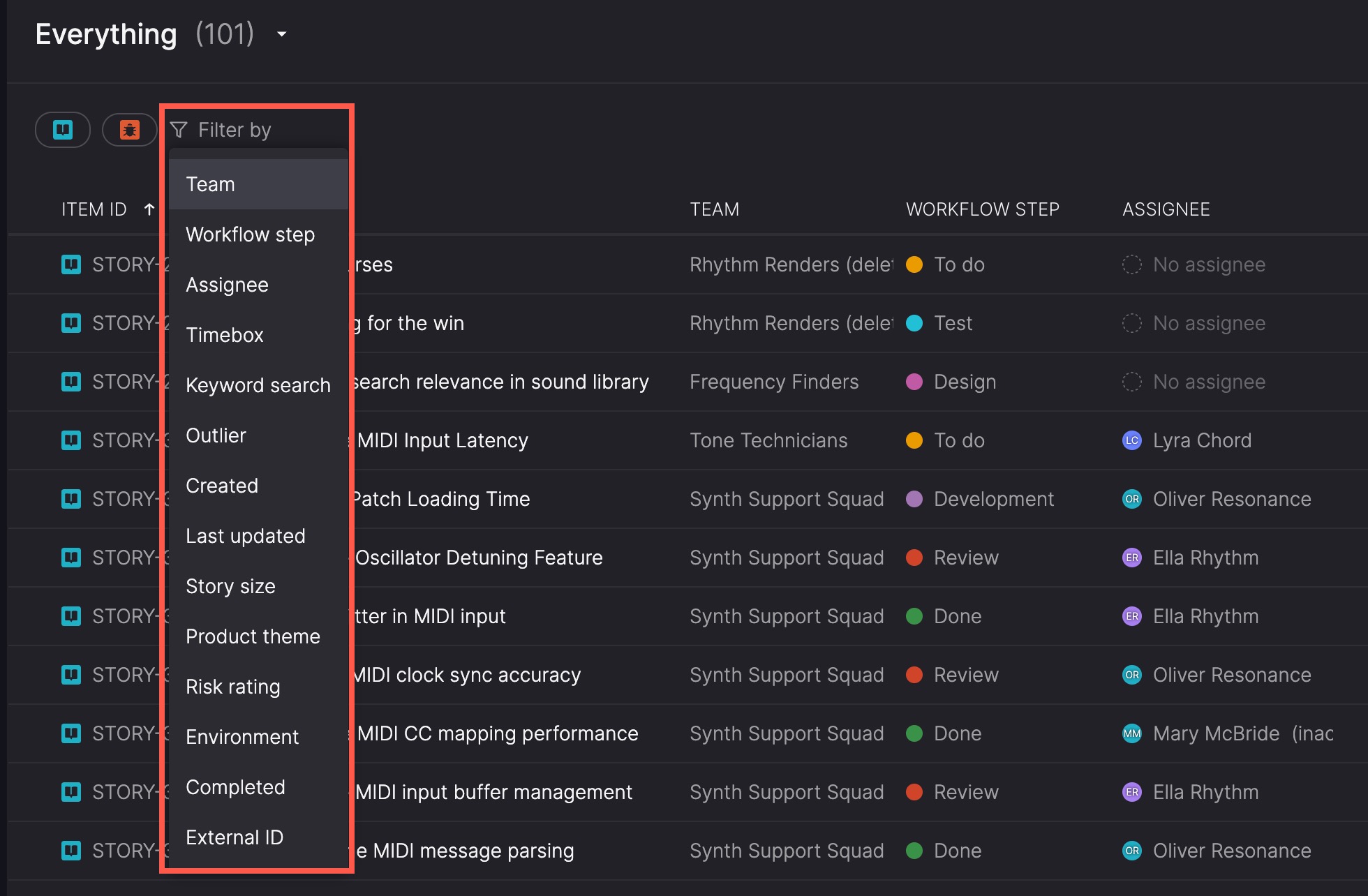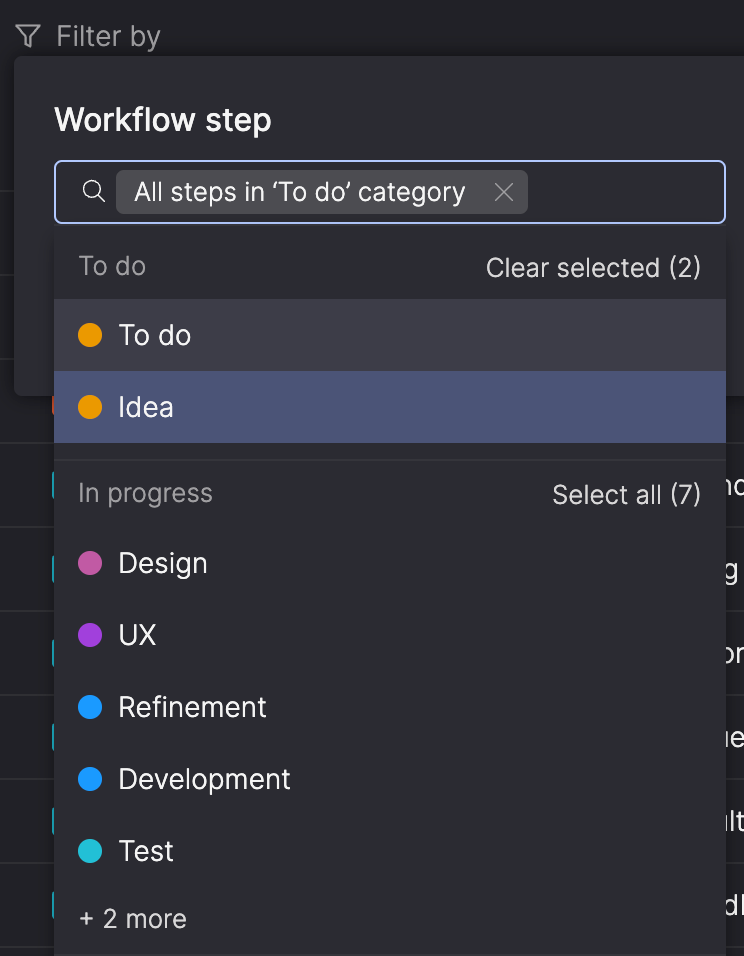Everything
View and manage all your work items in one place.
The Everything page provides a centralized view of all the items in your workspace, spanning teams, projects, and workflows. Use it to locate specific stories or bugs using search and filters, monitor progress across teams, and customize views to suit your needs.
The page title displays the total number of items you have permission to view in the workspace and the number of currently visible based on filters and search criteria. For example '215/400' indicates that 215 of the 400 items you have access to are displayed in the list.
What about private team items?Items from private team backlogs you're not a member of are excluded when accessing the Everything page directly. If accessed from a context where private team items are included, such as viewing all items in a timebox, their information will be redacted for users without permission to view the private team’s backlog.
Filter the list
Find items that match specific criteria by applying one or more filters. For example, you could filter for stories from a specific product theme that are done.
- Use the icons at the top of the table to choose whether to show Stories, Bugs, or both. At least one must be selected to display any items.
- Click Filter by at the top of the table.
- Select a filter and fill in any required details.
- Click Done.
- Repeat steps 2-4 to add additional filters as needed.
The list updates to display only items matching criteria from all filters.
For multi-select filters, items matching any of the selected values are included. For example, using the Workflow step filter to view items in To do and Design includes items in either step.

Available filters
Filters refine the list to display items matching specific criteria.
| Filter | Description |
|---|---|
| Team | View items on selected team backlogs, or items 'No team'. |
| Workflow step | Narrow results to specific steps of workflows. See Understanding the Workflow step filter for more details. |
| Assignee | Filter by the user the item is assigned to, or 'No assignee'. |
| Timebox | Show items within selected timeboxes, or 'No timebox'. |
| Keyword search | Show items with a specified keyword in their Item ID or title. |
| Outlier | Show items marked as outliers. |
| Created* | Set a date and time range for when items were created. |
| Last updated* | Set a date and time range for when items were last updated. |
| Story size (stories) | Filter by story size, or 'Unsized'. |
| Product theme (stories) | Filter by selected product themes, or 'No product theme'. |
| Risk rating (bugs) | Specify a risk level range, or 'Not rated'. |
| Environment (bugs) | Filter by the affected environments, or 'None selected'. |
| Completed* | Set a date and time range for when the item was completed (when it moved into a workflow step in the 'Done' category). |
| External ID | Show items with an external ID. This ID identifies the item in another system, such as issues imported to Atono from Linear. |
*When using the Created, Last updated, or Completed filters, you can specify absolute or relative date ranges and include the time of day to narrow your search further. For details, see Filtering by date and time.
Understanding the Workflow step filter
The Workflow step filter helps you narrow down items based on their current workflows step. Steps are organized by category—To do, In progress, Done, and Won't do—to reflect how work progresses through workflows.
How it works
- Step organization: Workflow steps are grouped by category, but since workflows are customizable, steps with the same name may appear in different categories. For example, one team might categorize 'Stakeholder Review' as In progress, while another team categorizes it as Done. Step names are deduplicated within each category, but not across categories.

- Selecting steps: You can select individual steps within a category or choose Select all to include all steps in a category. When all steps in a category are selected, the filter displays 'All steps in '[name]' category' instead of listing each step individually.

- Clearing steps: To remove individual steps from the filter, deselect them in the list or click the X next to their name in the search bar. If you chose to select all steps in a category, you can click Clear selected to remove them all.
What counts as an update?
The Last updated column reflects changes to an item's properties. Updates include:
- Title
- Backlog position (for example, reordering in list or board view)
- Assignee
- Description and ACs
- Associated feature flags
- Team
- Risk rating
- Size
- Workflow step
- Timebox
- Product theme
Filtering by date and time
Use the Created, Last updated, and Completed filters to find items within a specific date or time range. You can define an exact date range or choose a relative timeframe such as Today or Last week.
All dates and times are interpreted in your local timezone, as detected by your browser.
Date range
Choose Date range to specify exact start and end dates. Each date field includes a calendar picker where you can select days, and if needed, adjust the times.
The default start and end times are 12:00 AM (start of the selected Start date) and 11:59 PM (end of the selected End date). You can adjust these values to include specific hours and minutes for greater precision.
To create an open-ended range, select No start date or No end date. For example, choosing No start date and an end date of June 26, 2025 includes all items created on or before that date.
When a date range is applied, it appears in the filter pill. For example:
Created: May 26, 2025 - June 26, 2025Last updated: May 26, 2025 (1:00 PM) - June 26, 2025 (4:59 PM)Completed: May 26, 2025 - No end dateCompleted: No start date - June 26, 2025
Relative timeframes
Instead of specific dates, you can choose from preset relative options.
Less than / More than n days ago
These filters compare item timestamps relative to the start of the current day (12:00 AM) in your local time zone—not the exact current time. For example:
Less than 3 daysago includes items from 12:00 AM three days ago up to now. Today counts as one of those days.- If it's 10:00 AM on June 10, this filter includes everything from June 8 12:00 AM to June 10, 10:00 AM.
More than 3 daysago includes items created before the start of that day.- If it's 10:00 AM on June 10, this filter includes everything created before June 8, 12:00 AM.
Calendar-based timeframes
Use these options to quickly filter by standard calendar periods such as Today, Yesterday, This week, Last week, This month, or Last month.
These filters are based on calendar boundaries in your local time zone, not on relative day or hour counts. For example:
Today: 12:00 AM today up to the current time.Yesterday: 12:00 AM to 11:59 PM of the previous day.This week: Monday 12:00 AM up to the current time.Last week: Monday 12:00 AM to Sunday 11:59 PM of the previous week.This month: 12:00 AM on the 1st day of the current calendar month to the current time.Last month: 12:00 AM on the 1st day to 11:59 PM on the last day of the previous calendar month.
Calendar-based filters always align with standard calendar boundaries (weeks run Monday—Sunday, months follow full calendar months). The range for "this" periods updates dynamically as time progresses.
Timezone behaviorRelative filters use the local time zone of the person viewing the results. If a saved or shared view includes a relative filter, each viewer sees results based on their own time zone. This ensures filters align with each user's local calendar boundaries and working hours, but may lead to minor differences in included items between users in different time zones.
Modify a filter value
- Click on the filter above the table.
- Modify its value, then click Done.
The table automatically updates to display items that match the updated filter criteria.
Add or remove columns
Customize the Everything table by adding or removing columns to focus on the most relevant details for your current task.
- Click the Columns icon in the table header.
- Select or clear checkboxes to add or remove columns.

Available columns
Certain columns are specific to item types (for example, Risk rating for bugs).
| Column | Description |
|---|---|
| Item ID | The item type and ID, e.g., BUG-356 or STORY-47. |
| Title | The item's title. |
| Team | Name of the team backlog the item is assigned to, or 'No team'. Stories unassigned to a team are available in Story refinement. Bugs unassigned to a team, are available in Bug triage. |
| Workflow step | Name of the workflow step the item is currently in. |
| Workflow step - Icon | Select to include the workflow step icon. |
| Assignee | Name of the assigned user or 'No assignee'. |
| Assignee - Icon | Select to include the assignee icon. |
| Timebox | Timebox the item is included in, or 'No timebox'. |
| Outlier | Indicates whether the item is marked as an outlier ('Yes' or 'No'). |
| Story size (stories) | Size of the story, or 'Unsized'. When the table is filtered to a single team, the column header displays the total story points of all visible stories in the list. |
| Product theme (stories) | Product theme assigned to the story, or 'No product theme'. |
| Risk rating (bugs) | Risk rating of the bug, or 'Not rated'. |
| Environments (bugs) | Affected environments, or 'None selected'. |
| Created | Date the item was created. |
| Last updated | Date the item was last updated. |
| Completed | Date the item was completed (moved into a step in the 'Done' category of the workflow). |
| External ID | ID that identifies the item in another system, for syncing or integration |
Save and share views
Save filters, sorting, and columns as a view so you can reuse it later, share it with others, or add it as a widget to your homepage.
Learn more about Saving and sharing views.
Remove a filter
To remove a filter, click the X on the filter pill.
Add items to a timebox
Group multiple items into a timebox directly from the Everything page.
This is especially helpful when you've filtered or searched for specific items, such as all the stories within a product theme, across different workflows and want to group them for prioritization or delivery.
- Use filters to narrow your search.
- Hover over the item you want to add to a timebox.
- Select the checkbox at the start of the row.
- Select additional items or use the checkbox in the table header to select all items (available for lists of 200 or fewer items).
- Click the Add items to timebox icon.

- In the Add to timebox dialog, search for or select a timebox, and then click Add to timebox.
If an item is already in a timebox, you'll receive a warning before switching it to a different one.
Updated 14 days ago
